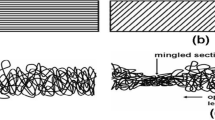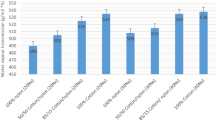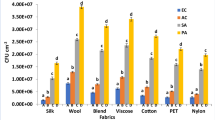Abstract
Functionality is of utmost importance for fabrics designed for military purposes, where woven fabric structural parameters and finishing processes greatly affect the definition and achievement of high set properties demands. Considering the application conditions of military fabrics and the high exposure to microorganisms from environment, as well as from the direct and indirect transfer between users, the possibility of contamination is unavoidable. Therefore, the aim of this paper is to determine whether and to what extent military fabrics have the properties of microbial barrier permeability. Determination of microbial barrier permeability was conducted according to the newly developed method. The most resistant forms of microorganisms were used, the bacterial endospores of apatogenic species: Geobacillus stearothermophilus and Bacillus atrophaeus. The analysis of the obtained results and the analysis of correlations between some relevant fabric properties confirm the extremely complex structural aspect of the woven fabrics. Tested woven fabrics designed for military purposes show a very good microbial barrier permeability with a different adhesion of microorganisms, conditioned by the complex woven fabric structure, based on which can be approached to further targeted functional designing of specific elements.
Access provided by Autonomous University of Puebla. Download conference paper PDF
Similar content being viewed by others
Keywords
1 Introduction
Military fabrics must meet a number of high set demands, and it is crucial that clothing and related equipment are lightweight, compact and durable and have high performance. The purpose of military camouflage fabrics is not only to assimilate with the environment, but also to protect from various conditions and situations in which body protection is of vital importance. Functional criteria of military fabrics should meet high camouflage and physical–mechanical and thermal requirements. Camouflage properties are achieved by specific patterns and colours application onto woven fabric, depending on the end-use conditions, with the aim of breaking the silhouette of the human body and achieving imperceptibility. Requirements of physical and mechanical properties set for these fabrics have a direct impact on psychological factors of individuals, which can cause psychological discomfort and instability that interfere with motivation and readiness to perform high-risk tasks. Military fabrics are produced in a combination of natural and synthetic fibres, which, with their specific properties and structural parameters, as well as additional chemical finishing (resistance to UV, water, heat, flame, wind), meets a wide range of requirements, all in order to achieve the needed properties [1,2,3]. Physiological (skin and temperature) and environmental variables (conditions of temperature, humidity and wind) are extremely important in achieving maximum comfort and safety while wearing a fabric. Its insufficient properties can cause a variety of negative phenomena (discomfort, climate imbalance, heat stress, the emergence of a large amount of nuisance, visual and cognitive disruption) affecting the person’s mental and physical stability [4].
Another extremely important feature of the fabric for military clothing, regarding the exposure to microbial influences, is the ability of body protection and control of microorganisms. Therefore, the question is whether and to what extent military fabrics have microbial barrier properties.
The subject of this research is fabrics designed for certain specific purposes, with high requirements for the human body protection, in order to preserve mental and physical health. The use of fabrics for military purposes in real application conditions (in various areas of habitation and activity) represents indispensable exposure to a possible microbial contaminated environment and thus a danger of microorganism’s penetration and body contamination. The reason for this is the fabric ability to retain moisture, which represents a possible cause of endangering the health of an individual. Textile materials are in constant contact with microorganisms, not only from skin but also from the environment. Textile material is a media that supports the microorganism’s growth and development, because it provides them an environment rich in nutrients necessary for their survival (moist air or wet textile product). Microorganisms are fed with skin cells and various substances used in chemical finishing processes (and also dirt) [5,6,7,8]. The growth of microbes implies increasing their cells, but also increasing their number after multiplication, resulting in colony formation. Microorganism’s growth and development depend on many factors, both physical and chemical, as well as about the environment in which they are located. Methods of microbial transmission are different, through direct and indirect contact with contaminated surfaces, contaminated environment (water) and even non-hygienic conditions [9]. In order to provide maximum body protection from microorganism penetration in real application conditions, the fabric should have sufficient microbial barrier properties.
2 Materials and Methods
The fabrics used in this research are designed and produced for military purposes in tt. Čateks, Croatia. The fabric samples contain equal ratios of natural and synthetic fibres (cotton/PA 6.6 and cotton/PES), with mass per unit areas from 220 to 280 g/m2, and woven in different weaves (Fig. 1). After weaving process, the fabrics were subjected to dyeing process, using reductive dyes to print camouflage patterns (“forest” and “desert” patterns) depending on the fabric end-use conditions. To achieve the needed properties, the fabrics were treated with protective coatings of water and oil repellents, which, together with the properties achieved by the fabric structural parameters, provides exceptional characteristics of strength, durability, comfort and stability.
The relevant structural parameters of woven fabrics were determined in accordance with the standardized testing methods, based on which further analysis was carried out:
-
mass per unit area—m (g/m2)—determination of mass per unit length and mass per unit area, in accordance with the standard HRN ISO 3801:2003,
-
fabric thickness—t (mm)—determination of thickness of textiles and textile products, in accordance with the standard HRN EN ISO 5084:2003,
-
fabric density—d (threads/10 cm)—determination of the number of threads per unit length, in accordance with the standard HRN EN 1049-2-2003.
The following tests were also performed:
-
determination of fabric air permeability, according to the standard HRN EN ISO 9237:2003
-
determination of fabric breaking properties, according to the standard ISO 13934-1:1999
-
determination of fabric thermal resistance (“hot plate”), according to the standard ISO 11092:1993
-
determination of microbial barrier permeability according to the newly developed method. Tests were performed according to the following procedure: A test specimen of 22 cm × 22 cm is fixed to a ring-shaped device (Fig. 2) and placed into a transparent sterilization pouch. It is sterilized in the steam sterilizer Selectomat PL MMM (Münchener Medizin Mechanik) at 134 °C for 5 min. After the sterilization procedure under sterile conditions, the bacterial endospores of apatogenic species, in this case Geobacillus stearothermophilus 105 and Bacillus atrophaeus 106, are applied to the test area of the specimen. This is followed by incubation for 24 h. Afterwards, a CT3P agar print plate is used to take prints, first from the face side and afterwards from the back side. After taking prints, CT3P agar print plates are placed into a thermostat at 35 °C in order to perform incubation for 72 h, after which the number of bacterial colonies on the face and back sides of the fabric is read [10, 11].
3 Experimental and Results
The materials used in this paper are woven fabrics which are mainly used for the purpose of military clothing. The materials are composed of natural and synthetic fibres blends (cotton and PA 6.6, cotton and PES, in equal proportions of 50%) with a nominal yarn finesses (Tt) shown in Table 1. The natural fibre component provides comfort and flexibility, while the synthetic fibre component provides strength and resistance properties necessary for final application.
The basic structural parameters of tested woven fabric samples are shown in Table 1.
The difference of PA 6.6 and PES fibre properties, in a certain part, affects the yarn properties and thus the properties of finished woven fabrics. The values of standard strength range from 30 to 68 cN/tex for PA 6.6 and from 25 to 55 cN/tex for PES fibres. Apart from the raw material that carries the basic characteristics of the yarn, many other parameters, such as yarn structure and the fabric construction (density and weave), have an influence on the final woven fabric properties. The results of breaking properties, as well as thermal resistance and air permeability properties of tested fabric, are shown in Table 2.
Thermal resistance property of woven fabric used for military clothing is of utmost importance, regarding the extreme application conditions, where the influence of the environment (coldness in the winter and the heat in the summer days) affects the psychophysical condition of a person wearing a certain fabric. The results of tested woven fabrics show that the highest thermal resistance has Fabric II, with value of 0.0203 m2 KW−1, which is woven in a twill 2/2 weave with two-ply yarns (with more closed structure), preventing heat transfer through the yarn (Table 2). This means that such fabric has better properties of heat retention near the body, which is suitable for application during colder periods. Conversely, Fabric III shows the lowest thermal resistance with 0.0127 m2 KW−1, despite the fabric highest mass per unit area. The reason for this can be found in the structural characteristics of the fabric, which is woven with one-ply yarns, whose structure is more open and thus more susceptible to heat penetration. Furthermore, this Fabric III is woven in satin weave characterized by strong flotation, which additionally provides easier heat penetration between the threads.
Analysing the results of the air permeability tests (Table 2), it can be concluded that the structural parameters of the fabric, as well as the applied apertures, have influenced the low air permeability of the tested samples. The obtained results diametrically follow the thermal resistance values, where Fabric II provides the highest values of air permeability (35.972 mm/s) and Fabric III the lowest values (10.220 mm/s). This can be explained by structural parameters of Fabric III, i.e. in highest density of the warp and weft threads, which with its compactness affects the fabric cover and porosity, thus making the air transfer through such woven structure difficult.
The results of microorganism permeability through the fabric structure testing, carried out according to the newly developed method, are shown in Table 3. It is important to note that all tested samples were equally contaminated, with the same number of microorganisms (105 Geobacillus stearothermophilus and 106 Bacillus atrophaeus) applied on the face side of the fabrics. An interesting indication is that the number of microorganisms transmitted from the biological indicator to the face of the fabric differs significantly between the tested samples. This is caused by the fabric surface, conditioned by the fabric structural parameters and the applied apertures. Fabric III, woven in Satin weave (with a large flotations and a rare thread interlacing) retain on face side 992 CFU, Fabric II 540 CFU (45.6% less than Fabric III) and Fabric I (with the most frequent threads interlacing) even 82.5% less than Fabric III, only 174 CFUs. Despite the largest number of bacterial colonies on the face side of Fabric III, not one microorganism has passed through fabric to the back side, which shows its exceptional microbial barrier properties (Fig. 3). Furthermore, the remaining two samples, Fabric I and Fabric II, with a minimum number of only 1 CFU on the back side of fabrics, prove good fabric properties of microbial barrier permeability.
By analysing the ratio of applied and passed through CFUs from face to back sides of the fabrics, it can be concluded that there is a significant difference between Fabric I and Fabric II. The ratio of CFU on the face side and back side of Fabric II is 540:1, whereas this ratio in Fabric I is 174:1. Above mentioned shows that for the transition of 1 CFU on the back side of the Fabric I is required 174 CFU applied on face side; while in Fabric II, the required amount of applied bacterial colonies is three times higher. This points to the conclusion that Fabric II has a better microbial barrier property, which can, once again, be explained by the fabric weave, regarding the approximately uniform structural fabric parameters. The twill 2/2 weave does not have abrupt or irregular thread interlacing, but the warp and weft threads are lined in identical proportions, with slight gradual shift, without any major bending. In contrast, the weaves with the most frequent interlacing and transitions from the face to the back sides of the fabric in a specific pattern (plain, rib) define more pronounced pores, allowing easier penetration of microorganisms through the fabric.
Correlation analysis was used to discover the degree of correlation between tested parameters, and the most interesting correlations, based on which significant conclusions were drawn, are presented in Table 4.
The air permeability property shows a very good correlation with the fabric thickness parameter (r = −0.83453), which is directly influenced by the fabric density, i.e. the density of warp and weft threads.
Statistical analysis of correlation indicators shows a strong dependent relation of thermal resistance property with the fabric thickness parameter (r = −0.96883). The results also show a strong correlation of thermal resistance with air permeability property (r = 0.94500), where the increase of air permeability (caused by decrease of fabric thickness) affects the increase of fabric thermal resistance, i.e. the ability of fabric heat retaining near the body.
Placing into correlation relations, the microbial barrier fabric properties with the fabric structural parameters indicate weaker correlation connections, which are still classified as good correlation (r = −0.76170). This is understandable considering that the microbe penetration is performed in a dry state, i.e. by mechanical penetration, which is affected by the fabric thickness parameter and thus the fabric density. Air permeability and thermal resistance properties are in poor correlation with the fabric microbial barrier property. The reason for this is, already mentioned, complex structural aspect of woven fabric, i.e. the constructional parameters and specific weave. The way of interlacing of warp and weft threads, which affects the fabric cover and compactness, as well as the pores structure, greatly influences the ability of adhesion and transition of microorganisms through the fabric.
All of the above findings are of utmost importance for the design process of woven fabric for specific purposes, which enable defining and achievement of the desired fabric properties depending on the end use, i.e. application conditions.
4 Conclusion
Based on the conducted research, it can be concluded that all of the relevant military fabric properties, including the microbial barrier property, are greatly affected, besides finishing processes, by the fabric structural parameters. The analysis of the obtained results and the analysis of correlations between some relevant properties confirm the extremely complex structural aspect of the woven fabrics. Tested fabrics for military purposes show very good microbial barrier properties, with the indicated differences, based on which can be approached to further targeted functional designing of specific elements.
References
Wilusz, E.: Military textiles. Woodhead Publishing Limited, Cambridge, England (2008)
Sparks, E.: Advances in military textiles and personal equipment. Woodhead Publishing Limited, Cambridge, England (2012)
Winterhalter, C.A., Lomba, R.A., Tucker, D.W., Martin, O.D.: Novel approach to soldier flame protection. J. ASTM Int. 2(2), 227–232 (2005)
Mijović, B., Skenderi, Z., Salopek, I.: Comparison of subjective and objective measurement of sweat transfer rate. Coll. Antropol. 33(2), 315–320 (2009)
Thiry, M.C.: Prescription textile protection. AATCC Rev. 10, 30–36 (2010)
Teufel, L., Redl, B.: Improved methods for the investigation of the interaction between textiles and microorganisms. Lenzing. Ber. 85, 54–60 (2006)
Beck, W.C., Carlson, W.W.: Aseptic barriers. Arch. Surg. 112(2), 2240–2244 (1981)
Borkow, G., Gabbay, J.: Biocidal textiles can help fight nosocomial infections. Med. Hypotheses 70, 990–994 (2008)
Duraković, S.: Opća mikrobiologija. Prehrambeno-tehnološki inženjering, Zagreb (1996)
Rogina-Car, B., Budimir, A., Katović, D.: Microbial barrier properties of healthcare professional uniforms. Text. Res. J. 87(15), 1860–1868 (2017)
Rogina-Car, B., Budimir, A., Turčić, V., Katović, D.: Do multi-use cellulosic textiles provide safe protection against the contamination of sterilized items? Cellulose 21(3), 2101–2109 (2014)
Acknowledgements
The financial support was provided within the framework, Support scientific research 2017, “Natural Fibres Agrotextile” (TP 12/17), financed by the University of Zagreb.
Author information
Authors and Affiliations
Corresponding author
Editor information
Editors and Affiliations
Rights and permissions
Copyright information
© 2019 Springer Nature Singapore Pte Ltd.
About this paper
Cite this paper
Schwarz, I., Rogina-Car, B., Brunsek, R. (2019). Woven Military Fabrics from the Aspect of the Microbial Barrier Permeability. In: Majumdar, A., Gupta, D., Gupta, S. (eds) Functional Textiles and Clothing. Springer, Singapore. https://doi.org/10.1007/978-981-13-7721-1_2
Download citation
DOI: https://doi.org/10.1007/978-981-13-7721-1_2
Published:
Publisher Name: Springer, Singapore
Print ISBN: 978-981-13-7720-4
Online ISBN: 978-981-13-7721-1
eBook Packages: Chemistry and Materials ScienceChemistry and Material Science (R0)







